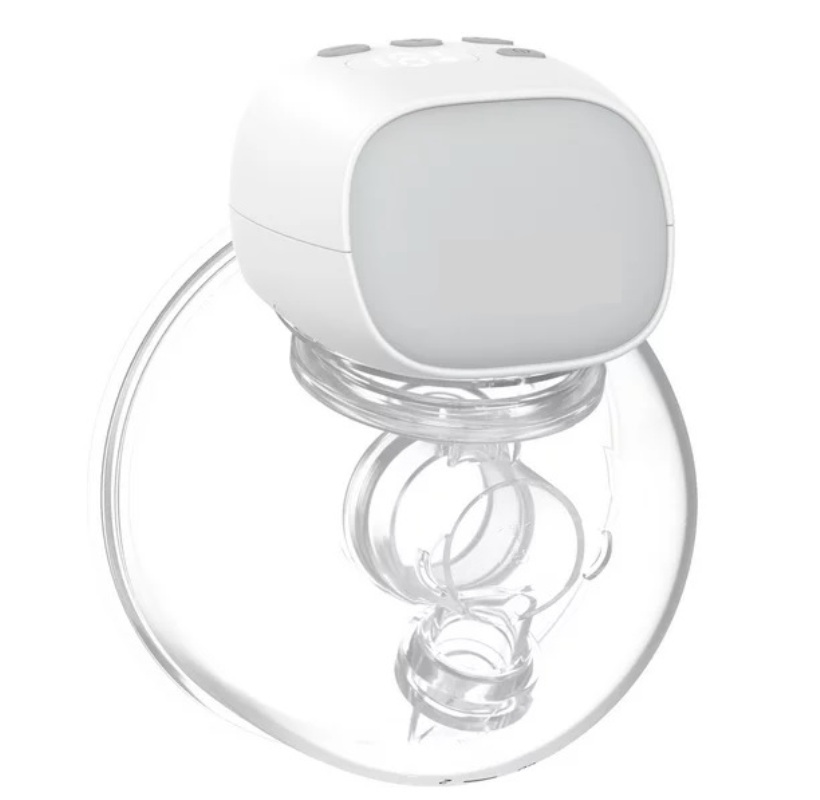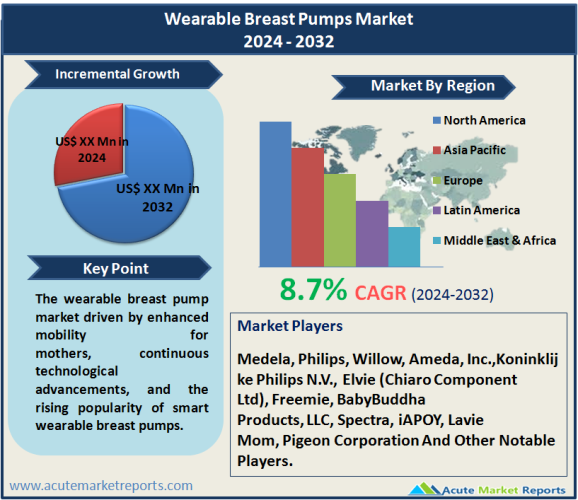
The wearable breast pump market is expected to grow at a CAGR of 8.7% from 2025 to 2033, driven by enhanced mobility for mothers, continuous technological advancements, and the rising popularity of smart wearable breast pumps. Challenges related to design and ergonomics necessitate ongoing improvements to ensure user satisfaction. The segmentation analysis highlights the dominance of wearable pumps and the growing importance of accessories in meeting user needs. Geographically, diverse trends indicate opportunities for targeted market strategies. The competitive landscape, led by key players, emphasizes the importance of user experience and technological innovation in sustaining market leadership. Major players such as Medela, Philips, and Willow are driving innovation and market growth. This overview provides a detailed analysis of the market's drivers, restraints, and segmentation, shedding light on the diverse components, technologies, and geographic trends that shape the industry. As the market progresses from 2025 into the forecast period, a dynamic and competitive landscape is expected, with companies adapting to evolving user preferences and global trends.
Enhanced Mobility and Convenience for Mothers
One of the primary drivers propelling the wearable breast pumps market is the enhanced mobility and convenience they offer to lactating mothers. Medela, a key player, has been at the forefront of developing wearable pumps that provide mothers with the freedom to move while pumping. Real-world testimonials and user reviews consistently highlight the positive impact of wearable breast pumps on mothers' daily lives, allowing them to multitask and maintain an active lifestyle while breastfeeding.
Advancements in Wearable Pump Technologies
Continuous advancements in wearable pump technologies drive the market. Philips, a leading innovator, has invested significantly in developing sophisticated yet user-friendly wearable breast pumps. The evidence supporting this driver includes patents and technological breakthroughs that improve the efficiency, comfort, and ease of use of wearable breast pumps. Technological features such as customizable settings and quiet operation contribute to a positive user experience.

Growing Emphasis on Smart Wearable Breast Pump
An emerging driver in the wearable breast pump market is the growing emphasis on smart wearable breast pumps. Willow, a key player, has contributed to this trend by introducing smart pumps that can be controlled through mobile applications. The evidence supporting this driver includes market trends indicating an increasing demand for smart wearable breast pumps with features such as real-time tracking, data analytics, and connectivity to smartphones.
Challenges in Design and Ergonomics
Despite the market's growth drivers, challenges related to design and ergonomics act as a restraint. The evidence supporting this restraint includes user feedback and reviews highlighting issues such as discomfort, fitting challenges, and the need for improvement in the overall design of wearable breast pumps. Industry stakeholders face the challenge of balancing technological features with user comfort and ensuring a seamless user experience.
Market Analysis by Component: Wearable Pumps Dominate the Market
In the component segmentation of the wearable breast pumps market, wearable pumps and accessories are key categories. In 2024, wearable pumps emerged as the highest revenue-generating component, driven by the increasing adoption of standalone wearable pumps. However, during the forecast period from 2025 to 2033, accessories such as breast shields and storage containers are expected to exhibit the highest compound annual growth rate (CAGR), reflecting evolving user preferences.
Market Analysis by Technology: Battery-Operated wearable breast pump Dominate the Market
The market's technology segmentation includes manual wearable breast pumps, battery-operated wearable breast pumps, and smart wearable breast pumps. In 2024, battery-operated wearable breast pumps accounted for the highest revenues, indicating a preference for the convenience of battery-powered devices. However, during the forecast period from 2025 to 2033, smart wearable breast pumps are expected to exhibit the highest CAGR, driven by the integration of advanced features.
North America Remains the Global Leader
Geographically, the wearable breast pumps market exhibits diverse trends. In the forecast period from 2025 to 2033, Asia-Pacific is expected to witness the highest CAGR, driven by increasing awareness of breastfeeding benefits and a growing population of working mothers. Meanwhile, North America is anticipated to maintain its position as the highest revenue-generating region, owing to a high level of awareness, favorable reimbursement policies, and a robust market presence of key players.
Market Competition to Intensify during the Forecast Period
The wearable breast pump market's competitive landscape is characterized by key players, including Medela, Philips, Willow, Ameda, Inc.,Koninklijke Philips N.V., Elvie (Chiaro Component Ltd), Freemie, BabyBuddha Products, LLC, Spectra, iAPOY, Lavie Mom, and Pigeon Corporation. These companies are expected to maintain their leading positions in 2024 and throughout the forecast period from 2025 to 2033. Medela's focus on mobility, Philips's commitment to technological advancements, and Willow's innovation in smart wearable pumps contribute to their strong market presence. The overall outlook suggests a competitive market where companies strive to address user concerns and stay ahead in terms of technological innovation and user-centric design.
Historical & Forecast Period
This study report represents analysis of each segment from 2023 to 2033 considering 2024 as the base year. Compounded Annual Growth Rate (CAGR) for each of the respective segments estimated for the forecast period of 2025 to 2033.
The current report comprises of quantitative market estimations for each micro market for every geographical region and qualitative market analysis such as micro and macro environment analysis, market trends, competitive intelligence, segment analysis, porters five force model, top winning strategies, top investment markets, emerging trends and technological analysis, case studies, strategic conclusions and recommendations and other key market insights.
Research Methodology
The complete research study was conducted in three phases, namely: secondary research, primary research, and expert panel review. key data point that enables the estimation of Wearable Breast Pumps market are as follows:
Market forecast was performed through proprietary software that analyzes various qualitative and quantitative factors. Growth rate and CAGR were estimated through intensive secondary and primary research. Data triangulation across various data points provides accuracy across various analyzed market segments in the report. Application of both top down and bottom-up approach for validation of market estimation assures logical, methodical and mathematical consistency of the quantitative data.
| ATTRIBUTE | DETAILS |
|---|---|
| Research Period | 2023-2033 |
| Base Year | 2024 |
| Forecast Period | 2025-2033 |
| Historical Year | 2023 |
| Unit | USD Million |
| Segmentation | |
Component
| |
Technology
| |
|
Region Segment (2023-2033; US$ Million)
|
Key questions answered in this report